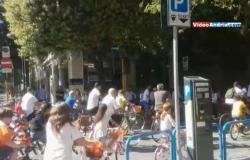- Home
- News
- Livorno “Capital” of counterfeiting, data from the Irpet report
News
April 5, 2024
Illegality and crime, Giani: “Tuscany keeps its guard high”
Livorno 5 April 2024 – Livorno “Capital” of counterfeiting, data from the Irpet report
According to Irpet estimates, the economy connected to illegal activities, i.e. the set of products whose production, sale or distribution is prohibited by law, is worth a turnover of 1.2 billion euros in Tuscany.
If we add to this figure the 10.1 billion attributable to the underground economy (which includes activities hidden from the tax authorities), the overall value of the non-legal activity observed in the regional territory can be quantified at 11.3 billion; it represents 11.7% of the regional gross domestic product, a percentage overall in line with the national figure.
These are some of the most significant data that emerge from the 146 pages of the “2023 Report on illegality and organized crime in the Tuscan economy” drawn up by Irpet, the Regional Institute for Economic Planning of Tuscany.
The report was presented in Florence in the Royal Palace of the Santa Maria Novella station during an event attended by the president Eugenio Giani and the councilor for legality Stefano Ciuoffo, together, among others, with the public prosecutor of Florence, Filippo Spiezia.
The President of the Tuscany Region Eugenio Giani comments:
“The mafias are fought by speaking out loud and giving us the necessary tools for study and analysis. For this reason we can only express appreciation and gratitude for all those who worked on this new edition, which makes us all better equipped in the battle for legality.
Whatever type of crime it thrives if it is not given the right attention, if it is underestimated, without equipping itself with the right tools to recognize it and make it emerge in activities, relationships and operating methods. We carry out this operation every year. I also thank the state institutions, the Prosecutor’s Office and the Judiciary who support us in this fundamental task”.
Councilor Ciuoffo echoes Giani:
“Although the mafias do not have a stable territorial rooting in the region, Tuscany confirms itself as one of the privileged areas for money laundering activities and more generally for the implementation of large-scale financial economic crimes. The report strengthens us in the belief that we are on the right path, despite the continuous and constant change in organized crime.
Irpet demonstrates how Tuscany is a resilient territory and capable of implementing transversal actions to combat the mafia, in collegial work between institutions.
Today the mafias travel at the same speed with which new technologies evolve and we would be making an unforgivable mistake in having a stereotypical image of the mafioso.
For this reason, the study and analysis, which this Irpet report gives us, are essential for the effectiveness of our preventive action”.
The profile of the Tuscan provinces does not appear to be characterized by substantial socio-economic fragility.
But the report invites us to consider the so-called paper mill companies (those created with the intent of evasion, avoidance or money laundering through the issuing of invoices for non-existent operations) which account for 3.6% of the total, compared to 5% in Italy.
The sectors with the highest values are financial-insurance (6.6%), construction (5.8%) and trade (5.4%).
Anomalous (excess) company mortality is concentrated mainly in the clothing, leather goods and footwear sectors (Prato, Empoli). The excess use of part-time mainly concerns the area of northern Tuscany (with the highest rate of entrepreneurship), and in particular Prato, where it exceeds 40% of contracts, especially in the clothing sector.
Proceedings for mafia association
The report for the Judicial Year 2023 of the Attorney General’s Office reports a marked increase in proceedings for mafia association (from 13 to 28) initiated between July 2021 and June 2022.
The phenomenon of infiltration by foreign mafias raises particular alarm due to the links it can establish with local mafias, in particular the Chinese mafia, with high rates of economic and financial crime, and the Albanian mafia, specialized in international drug trafficking.
Comparison with other Regions
In the national comparison, Tuscany ranks last (in 16th place) for the domain “objective indicators of the presence of organized crime” (mafia-type association, criminal association, anti-mafia interdictions, managed and intended companies, managed properties and intended, financial operations relating to organized crime).
It is below the median for the domain “spy indicators of territorial control” (in 13th place), i.e. damage following violence, attacks, kidnappings, extortion, usury and corruption.
On the contrary, it presents more critical values and is among the top regions in the centre-north (in 9th place) for the domain “indicators of the exercise of illicit activities” (money laundering, counterfeiting, smuggling, narcotics, waste cycle crimes, exploitation of prostitution).
The synthetic indicator of the three domains places us halfway (10th place) in the national ranking. On a provincial basis, the highest value is in Livorno, followed by the area of the plain between Florence, Prato and Pistoia and the area of the central-southern coast.
Counterfeiting, a critical case
Specifically regarding illicit activities, Tuscany emerges as a critical case in the crime of counterfeiting.
Eight out of ten provinces exceed the national median value, while Florence, Prato, Grosseto and Livorno they are positioned in the group of Italian provinces with the highest values.
Florence and Prato are mainly involved in the production of counterfeit goods, Livorno and Grosseto, however, in the related logistics and subsequent distribution activities.
Reporting of suspicious transactions
The reports of suspicious transactions (SOS), which financial intermediaries and other qualified operators have the obligation to communicate to the Financial Information Unit (UIF) of the Bank of Italy, are in per capita terms in line with the central-northern regions , but the position is more critical if we look at some provinces: Prato appears in the top five followed by Siena, Florence and Lucca.
The trend of the risk indicator of anomalous use of cash (UIF) is not dissimilar.
Overall, the provinces of Prato and Florence are positioned at the national top, albeit together with other areas in the centre-north. Finally, the number of crimes reported relating to the waste cycle places Tuscany in 9th position, after the critical period between 2016 and 2019 (4th position). Particularly critical contexts are represented by textile waste in the Prato district, the trade of used clothing and waste from the tanning industry.
The Pnrr: opportunities and risks
The public works procedures associated with the Pnrr (17% of the regional total, 1,200 out of 6,700) are characterized by better performances compared to the others and, in some cases, also compared to the dynamics recorded in the recent past in Italy and Tuscany. Compared with similar works by administrations not financed by the Plan, they present a greater openness to competition represented by a wider use of open procedures (+12.6% in Tuscany, +10% in Italy) and a lower fragmentation of the clients represented by a greater use of centralized solutions (+10% in Tuscany, +20% in Italy).
Irregular work
Irpet estimates quantify an added value linked to irregular work in Tuscany of 3.6 billion, equal to 3.7% of the regional added value.
This incidence, which depends on the sectoral composition of the economy, is in line with the northern regions, and lower than the central-south.
In Tuscany in 2020 the number of irregular workers was 168 thousand units, 10.2% of the total, lower than the country average (12%), but not far from the realities of the north.
It is a phenomenon that has been decreasing in recent years (compared to 12.4% in 2000), with the exception of the agriculture sector, where it reaches 17.6% (compared to 13.8% in 2000).
In the manufacturing sector, a context traditionally less prone to irregular work, the Prato district represents a particularly critical area.
Overall, contribution evasion linked to irregular work is estimated for our region to be in the order of approximately 604 million euros.
Tax evasion: from Irpef to car tax
A quantification of the Irpef evaded in Tuscany returns an amount of just over 2.5 billion euros, in line with the national average.
The difference between due and paid in relation to the IMU in 2020 was equal to 23.2% with a loss of revenue of 319 million against an actual revenue of one billion.
The tax gap is higher in the more urbanized and industrialized local economic systems of the Florentine, Prato and Pisan areas. Estimates from Mef highlight the wide difference between the less virtuous territories (up to 40% of the theoretical revenue in Calabria) and the more virtuous regions (14% in Emilia Romagna). Tuscany is close to the country average, but with higher values than the central-northern regions.
Regarding the car tax, compared to a revenue in 2019 (pre-Covid year) of just over 450 million, the unpaid amount is 106 million, equal to 19% of the amount due.
If you look only at owned vehicles, the amount owed is 410 million and the unpaid amount is 72 million with an evasion of 18%.
Evasion of this tax is greater in the coastal provinces, Livorno, Grosseto and Massa Carrara, and in the province of Prato, as well as among the foreign population.
Read the Irpet report






